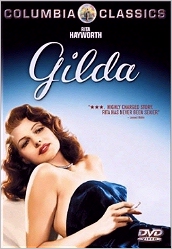 |
GildaColumbia |
|---|
 |
GildaColumbia |
|---|
|
Rita Hayworth - Gilda Mundson Glenn Ford - Johnny Farrell George Macready - Ballin Mundson Steven Geray - Uncle Pio Joseph Calleia - Obregon Joe Sawyer - Casey |
Charles Vidor - Director Virginia Van Upp - Producer Marion Parsonnet - Screenwriter Rudolph Maté - Cinematographer Jean Louis - Costume Design Doris Fisher - Music |
The legendary Rita Hayworth stars in Gilda, with Glenn Ford, a fine example of film noir despite a unfocused story and conventional ending. Directed by Charles Vidor, the E.A. Ellington story was adapted for the screen by Jo Eisinger who would go on to write the 1950 noir film Night and the City, and the screenplay written by Marion Parsonnet. Also lending an uncredited hand in the script was Ben Hecht, best known for his work on Alfred Hitchcock's Notorious (1946). The exceptional cinematography was by Rudolph Maté, who worked on the Hayworth films Cover Girl (1944) and The Lady from Shanghai (1948).
The film opens in Argentina just after World War II with rough and ready gambler Johnny Farrell (Ford) winning a game of craps with loaded dice. Shortly after being held up at gunpoint for his winnings he is inexplicably saved by George Macready as the suave casino owner Ballin Mundson. Though gambling is illegal in Argentina, Ballin invides Johnny to his casino, where he promptly cleans up at the blackjack table. Recognizing Johnny's abilities, Ballin allows Johnny to talk him into hiring him to run the casino and eventually makes him a partner in the business. The two men become close friends and partnership proves to be very successful and highly profitable.
Things get complicated when Ballin returns from a business trip with a new wife named Gilda (Hayworth), who is a woman from Johnny's past. They attempt to hide this fact from Ballin, but Gilda is insistent on using the opportunity to taunt Johnny by flaunting her marital indiscretions and the situation becomes even more volatile when Ballin insists that Johnny becomes Gilda's personal watchdog. Johnny and Gilda's mutual love/hate relationship takes an unexpected turn when Ballin's ties to former Nazis force Johnny into assuming complete control over Gilda. In the meantime, Ballin's operation is being investigated by an undercover cop. But despite the intrugue and illegal activities, it is the tension between the three central characters that remains the heart of the movie.
Rita Hayworth sizzles with sensuality and magnetism as she sings "Put the Blame on Mame" and, in fact, it is her immortal performance as the temptress title character that really carries the film. It is a B-movie with a script that is best when dealing with the witty dialoge between the main characters. But the plot itself is fairly obtuse and much is left unclear. Glenn Ford, who had co-starred with Hayworth under Vidor's direction six years earlier in The Lady in Question (1940), would also go on to team together in The Loves of Carmen (1948). Rudolph Maté's luminous black and white cinematography looks great, especially any time Rita Hayworth appears on the screen. Blacks have a rich, velvety quality and the picture boasts a smooth, but distinct rendering of the various shades of gray. Gilda is an overrated but enduring classic.
--THE NOIR 'NET
A selection of Gilda related films.
|
Find Gilda on eBay.com
A selection of Gilda related books.
|
|
home: The Film Noir 'net |
back: forward: FILM LIST ALMOST NOIR |
|
Any comments, additions or suggestions
should be adressed to: The Film Noir 'net / Eric B. Olsen / ericbolsen@juno.com |
Other Web Sites:
History of Horror Hard Bop Homepage The War Film Web Author Eric B. Olsen |